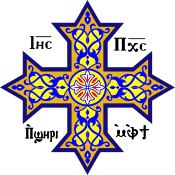Pachomian monasteries
| Part of a series on the |
| Copts |
|---|
| Culture |
| Regions |
| Denominations |
|
|
The Pachomian monasteries or the Koinonia of Upper Egypt were a group of Christian cenobitic monasteries founded by Pachomius the Great during the 4th century A.D. Altogether, by the mid-300s A.D., nine Pachomian monasteries formed a network or federation of monasteries known as the Koinonia.[1]
History[edit]
In 329 A.D., Pachomius founded the Koinonia (originally a Greek word from the New Testament meaning 'fellowship'), or network of monasteries, when he established the new monastery of Pbow and moved there from Tabennisi.[1]
List of monasteries[edit]
From north to south, the nine monasteries of the Koinonia were Tse, Tkahšmin, Tsmine, Tbew, Tmoušons, Šeneset, Pbow, Tabennesi, and Phnoum.[2]: 160 Tse, Tkahšmin, and Tsmine, formed a cluster near Panopolis in the north, while Tbew, Tmoušons, Šeneset, Pbow, and Tabennesi made up the core nucleus of five monasteries near the modern-day town of Nag Hammadi. Phnoum was located much further to the south, near Latopolis. Pachomius also founded two nunneries. They were not part of the Koinonia, which consisted exclusively of all-male monasteries.[1]
Each monastery was added to the Koinonia (monastic federation) in the following chronological order. Not all monasteries were newly founded or built by Pachomius when they were added to the koinonia; some were pre-existing monasteries.[2]
- Tabennesi
- Pbow
- Šeneset (or Sheneset)
- Tmoušons (or Thmoushons)
- Tse
- Tkahšmin
- Tbew (or Thbew)
- Tsmine
- Phnoum
Leadership[edit]
The leadership hierarchy of the Koinonia was as follows.[1]: 126
- Superior of the Koinonia, or "father" (apa or abba)
- Superior of the individual monastery, or "steward" (oikonomos). The vice steward, or steward's assistant, is known as the "second" (deuteros).
- "Housemaster" (oikiakos) of an individual house (oikos) within each monastery. A housemaster also had had an assistant or "second" (deuteros). Each house had around a few dozen monks, while each monastery had a few dozen houses.
Pachomius was the first superior of the Koinonia. After Pachomius's death, Horsiesius became the superior of the Koinonia. In 350, he was succeeded by Theodore when Horsiesius resigned. Horsiesius again became the superior of the Koinonia when Theodore died in 368.[1]: 119
Demographics[edit]
According to John Cassian, there was a total of 5,000 monks in the Pachomian monasteries. Palladius gave a figure of 3,000 monks during Pachomius's time, and 7,000 monks by the end of the 4th century. Ammon gave a figure of 600 monks at Pbow when he resided there in 352 A.D.[1]: 123
Archaeology[edit]
Archaeological excavations of Pachomian monasteries have been conducted at Tabennesi, Pbow, and Sheneset-Chenoboskion.
Manuscripts[edit]
Various manuscripts have been discovered near the locations of Pachomian monasteries, leading scholars to propose that they were likely part of Pachomian monastic libraries. Tbew, Tmoušons, Šeneset, Pbow, and Tabennesi are all located within a day's walk of each other, and so the texts were likely to have been borrowed and exchanged among the different monasteries.[3]: 220
See also[edit]
References[edit]
- ^ a b c d e f Harmless, William (2004). Desert Christians: An Introduction to the Literature of Early Monasticism. Oxford: Oxford University Press. doi:10.1093/0195162234. ISBN 978-0-19-516222-6.
- ^ a b Brooks Hedstrom, Darlene L. (2017-11-23). The Monastic Landscape of Late Antique Egypt: An Archaeological Reconstruction. Cambridge University Press. doi:10.1017/9781316676653.007. ISBN 978-1-316-67665-3.
- ^ Linjamaa, Paul (2024). The Nag Hammadi Codices and Their Ancient Readers. Cambridge: Cambridge University Press. ISBN 978-1-009-44148-3.

